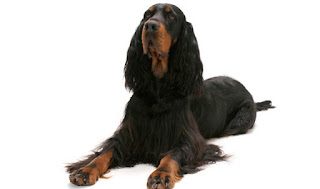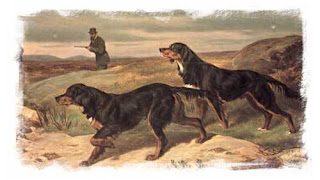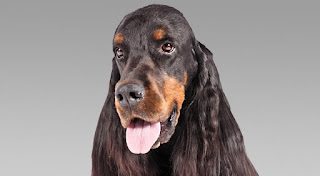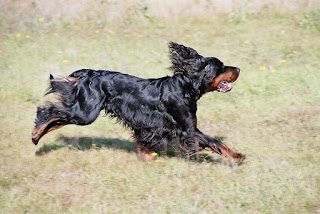Everything about your Gordon Setter
Originally deployed in Scotland to retrieve hunted birds that had fallen to the ground, the Gordon Setter’s strong hunter’s instinct, skill with scents, and general companion qualities have made it a very popular breed indeed, as well as an enduring one. Having been officially recognized by the American Kennel Club in 1884, it is far ahead of many modern breeds that could be considered more popular. Today, a Gordon Setter is known as an excellent, loyal, and obedient breed that looks great with a properly-groomed coat but is also an ideal exercise partner and friend in the outdoors.
Overview
This Scottish breed has been established since the 17th century and takes his name from Gordon Castle, where he was developed by the fourth Duke of Gordon. Dressed in sophisticated black and tan, the Gordon Setter is the heaviest and most muscular of the three Setter breeds. In the field, his job is to find and point gamebirds, working at a slow, methodical pace. Hunters appreciate his intelligence and scenting ability, but his good qualities aren’t limited to the field. enjoys participating in dog sports such as agility, obedience, rally, and tracking.
The gentle and protective Gordon can be a good choice for families with children. He’s tolerant toward toddlers and energetic enough to play catch for hours on end. He also gets along well with other pets such as cats if he’s raised with them. Gordon Setters are alert and will bark to let you know that someone is approaching. They are reserved toward strangers, preferring to save their affection for their families.
The Gordon is smart and easy to train with positive reinforcement techniques. Be patient and gentle, and he’ll respond eagerly. He’s not necessarily a barker, but he is vocal, expressing himself with mumbling and grumbling to tell you about his day, what he thinks of his meals, and when it’s a good time to take him for a walk.
Last but not least, it should go without saying that a people-loving dog like the Gordon Setter needs to live in the house. He’ll grow despondent relegated to the backyard with little or no human interaction.
Highlights
- Adult Gordon Setters require one to two hours of daily exercise. This can be a game of fetch in a field or backyard, a run, or a couple of long walks.
- Being an intelligent, hardworking breed, the Gordon Setter can become destructive if his needs for exercise and mental stimulation are not met. Boredom and extra energy are not a great mix to have, and the best way to avoid any destructiveness is through proper exercise and training.
- Gordon Setters are not backyard dogs. They are much happier when they are with their families and should not live away from them. They enjoy personal attention and family activities.
- Strong temperaments are well known in the breed and many owners have the feeling that they are “owned” and not owner. Gordons are independent and determined, qualities that can translate to stubbornness to some.
- Gordon Setters can suffer from separation anxiety and may become destructive when they do.
- Although Gordon Setters are known for their stubbornness, they can be sensitive and easily cowed with abuse and neglect. Never treat your dog harshly but instead give him firm, fair, consistent training without the use of anger or physical force. If Gordon Setters aren’t trained they may become destructive, wilful, and dominant.

- The Gordon is the largest of the three setter breeds.
- The Gordon dresses to the nines in a silky black coat with rich mahogany markings and feathering on the legs and tail.
- The Gordon is an uncommon breed. You may have a wait of a year or more before a puppy is available.
Comparable Breeds: Golden Retriever, Irish Setter
The loyal Gordon Setter is intensely devoted to his family but wary of strangers, characteristics that make him an excellent watchdog. He’s mannerly and eager to please, but like any dog he’ll take advantage of lax leadership and can become dominant, wilfull, and stubborn if not provided with firm, fair, consistent training.
A Gordon Setter expert once wrote of the breed that if he acts sorry for a misdeed, he’s probably more sorry that he got caught than that he misbehaved. In the field or in any competitive situation, he’s alert, fearless, intelligent, and capable. He’s a personal hunting dog, in the sense that he works nearby rather than ranging far afield. Gordons aren’t fast, but they have a lot of stamina.
Temperament is affected by a number of factors, including heredity, training, and socialization. Puppies with nice temperaments are curious and playful, willing to approach people and be held by them. Choose the middle-of-the-road puppy, not the one who’s beating up his littermates or the one who’s hiding in the corner. Always meet at least one of the parents — usually the mother is the one who’s available — to ensure that they have nice temperaments that you’re comfortable with. Meeting siblings or other relatives of the parents is also helpful for evaluating what a puppy will be like when he grows up.
Like every dog, Gordon Setters need early socialization — exposure to many different people, sights, sounds, and experiences — when they’re young. Socialization helps ensure that your Gordon Setter puppy grows up to be a well-rounded dog. Enrolling him in a puppy kindergarten class is a great start. Inviting visitors over regularly, and taking him to busy parks, stores that allow dogs, and on leisurely strolls to meet neighbors will also help him polish his social skills.
Health
The Gordon Setter, which has an average lifespan of 10 to 12 years, is prone to major health issues such as gastric torsion and canine hip dysplasia, and minor problems like cerebellar abiotrophy, progressive retinal atrophy (PRA), hypothyroidism, and elbow dysplasia. To identify some of these issues, a veterinarian may recommend regular eye, hip, thyroid, and elbow exams for this breed of dog.
Care
Regular combing, which should be done every two to three days, is a must for the Gordon Setter, though an occasional trimming may also be required. A thorough daily exercise regimen is also essential for the breed. And although it is adaptable to temperate climates outdoors, it should be given plenty of human companionship.
Living conditions
The Gordon Setter is not recommended for apartment life. It is relatively inactive indoors (if a Gordon Setter gets enough outdoor activity it will be calm when it is indoors) and does best with at least a large, safely fenced yard where it can run free. Their hunting instincts lure them to roam, so a good fence around your property is essential.
Trainability
Gordons have a mind of their own and do not like to be bossed around. Training can be difficult and takes a strong, steady leader. Sessions should be conducted with an abundance of positive reinforcement and very little harsh discipline. Though establishing leadership can be a challenge, Gordons actually pick up on tasks quickly and have excellent memories. Once basic obedience is mastered and the Gordon Setter knows his place in the family hierarchy, he should be graduated on to advanced obedience or agility training to keep his mind active.
Housebreaking takes anywhere from four to six months with a Gordon Setter. They do not like to be told what to do or when to do it, so this process can be quite drawn out. Crate training is the best method for housebreaking a Gordon.
Exercise Requirements
These are voracious exercisers and will require plenty of it to keep from bouncing around the walls indoors. For this reason, it’s not recommended that you keep a Gordon Setter as a city pet. They’re more suited for plenty of space to have their “outdoor” itch scratched on a daily basis, and they generally require plenty of activity to feel calm at the end of a day.
Grooming
The Gordon has a long, thick coat with feathering on the ears, legs, belly, and tail. Depending on the type of terrain your Gordon is out in every day, you will probably need to brush and comb him one to three days a week to prevent or remove tangles and mats, remove dead hair, and distribute skin oils. In addition to brushing, you’ll need to trim the hair on the bottom of his feet and between his toes.
The Gordon Setter sheds moderately. The more often you brush him, the less hair you will find on your floor, furniture, and clothing.
Gordons love swimming and playing in water. Be sure to keep the ears clean and dry to prevent bacterial or yeast infections from taking hold.
The rest is basic care. Trim the nails as needed, usually every few weeks. Brush the teeth frequently for good overall health and fresh breath.
Children And Other Pets
Gordons are fond of and protective toward children. They’ll put up with a lot, and when they’ve had enough teasing or roughhousing, they’ll walk away. They may be a bit much for toddlers, though, being large enough to accidentally knock them down.
Always teach children how to approach and touch dogs, and always supervise any interactions between dogs and young children to prevent any biting or ear or tail pulling on the part of either party. Teach your child never to approach any dog while he’s eating or sleeping or to try to take the dog’s food away. No dog, no matter how friendly, should ever be left unsupervised with a child.
Gordons get along with other dogs and cats if they’re raised with them, but they might not be so friendly toward strange dogs.







